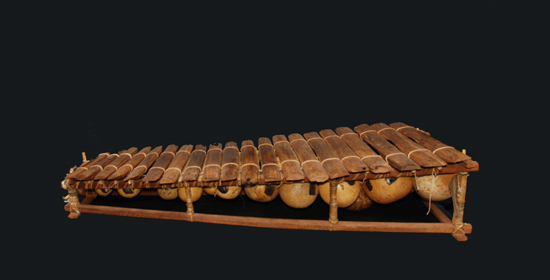
Owner: HWMC
Catalog#: AF-IDST-005-14
Source: “World Music: Traditions and Transformations” – Michael B. Baken, 2007 DjiDji, Jacqueline Cogdell, “Turn Up The Volume”. UCLA Fowler Museum of Cultural History, Los Angeles www.wikipedia.com www.Coraconnection.com
Balafons
Mandinka 'Balo' (20-Keys)
Guinea, Ivory Coast, Mali, Senegal, the Gambia, and Guinea-Bissau
Mandinka
Wood [Haré (Guéni, Yori’)] , Calabash, plastic
Mid-20th century
Height: 20 cm / Length: 110 cm / Width: 58 cm
Idiophone – Struck Directly
The ancient Mande empire, otherwise known as the Mali empire, spans across today’s West African nations of Mali, Guinea, Guinea-Bissau, Senegal, and Gambia. The Mande Empire rose from the legendary warrior and hero Sunjata Keita in the 13th century. According to legend, the spirits gave the (Sosso) balafon to Soumaworo Kante, who was Sunjata’s greatest adversary. Soumaworo would not allow anyone to play the balafon. During battle, Sunjata’s griot named Kiakouma Doua, was captured and imprisoned by Soumaworo. One day the griot took the liberty to defy Soumaworo’s warnings and played the balafon. Soumoworo was so impressed with his performance, he dubbed his prisoner “Dala Faséké Kwate” (the balfon player), making him the first public balaphonist and guardian of the balafon. This is an epic story that is still honored today.
This professional model balo (balenjeh, behlanjeh) of the Mandinka (The Mandinka are the western-most branch of the Mande family) heptatonic xylophone consists of a low flat trapezoidal shape frame with tapering bars/strips of Bala wood placed parallel atop the frame. Under each bar/strip is a gourd resonator of corresponding size. There are two holes in the calabash, one opened and directly underneath the bar and the second hold covered with a thin piece of plastic (originally: thin egg membrance), which gives the buzzing mirliton (like a kazoo) sound effect. This flat Heptatonic xylophone is from Mali and is played by using two mallets with natural rubber tips. The xylophone is often played by a griot, or balladeer to accompany (women) singing. The equidistant Heptatonic tuning of the xylophone is an approximate division of seven equal intervals per octave, which comes to a separation from one pitch to its adjacent by almost 2/3 of a whole step. This obviously does not correspond to the tones in the chromatic pitches of the western European scales.
